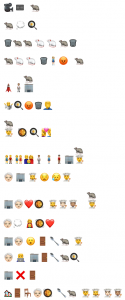
To make it easier for readers to figure out the title of the piece, I’ve purposely selected a movie that gives a distinct clue about the film: a rat emoji. First, I’ve identified that it is a film using a camera and a film roll emoji, then using the rat emoji as a keyword, or key image, readers should easily relate to the movie Ratatouille even if they have not seen the movie before. I think it is safe to make this assumption because there are not that many films about a rat. Given the fact that the emoji story contained repetitive use of the chef emoji, it is safe to say that this is a film about a rat that wants to be a chef, thus concluding that it is Ratatouille. I began creating an emoji storyline from the title just because it is the simplest way to go for this particular movie. I’ve also selected this movie because of the iconic rat and chef combination.
I thought this task was particularly interesting because many of my students that are novice readers tend to become more selective in what they want to read. Some who are already tired of the regular picture books, but are not ready or strong enough to read a full-text novel, have now begun to show interest in graphic novels. Graphic novels have gain popularity because it offers many benefits to struggling readers or even strong readers that are not interested in reading. As Kress mentioned that, “the fact that these occur as constellations—medium of book with mode of writing and now medium of screen with mode of image—means that the effect has been experienced in an amplified form” (2005). Relating his notion that the medium of books with modes of writing to now with mode of images is creating a different sense of experience for readers that struggle to understand what they’re reading based on text alone. Emerging learners that are learning to identify elements of a story based on the text and punctuations like question marks, exclamation marks, italic fonts, etc., struggled to understand the meaning and expressions of the story from text alone. With the enhanced element of added visuals beside texts, the students could make the connections of what is happening in the story by looking at the drawing of the expression on characters’ faces or observing the background setting more closely to infer what is happening in the story. With the quick evolution of computational text like magazines and books around the world, “What is happening is a readjustment of the ratio between text and image in the various forms of print” (Bolter, 2001, p.48), making the reading experience more transparent and easier for readers to relate and understand what the author is trying to convey.
As Kress pointed out in one section of the reading that the outdated textbooks were heavily text-focused. With modern teaching practices, we focus more on bringing the students out to experience hands-on learning experience because we learned that including various senses and experiences into learning, on top of all the required reading, greatly help student’s understanding of the material. So, to answer Kress’ question, “And can I say that depiction is a better means of dealing with much in the world than writing or speech could be?” (Kress, 2005), yes, I have to agree that a well-balanced text and image, especially emojis that people of all ages could easily understand, helps all learners to better understand what is presented to them.
References
Bolter, J. D. (2001). Writing space: Computers, hypertext, and the remediation of print (2nd ed.). Mahwah, N.J: Lawrence Erlbaum Associates. doi:10.4324/9781410600110
Kress (2005). Gains and losses: New forms of texts, knowledge, and learning. Computers and Composition, Vol. 2(1), 5-22.
Hi Judy!
Aw I was disappointed that you gave it away, but your synopsis makes it quite clear: there aren’t many movies with ‘chef’ ‘rats’.
I was interested by your mention of textbooks, and how they’ve evolved over the years to incorporate more visuals. This certainly lends to Kress’ characterization that “depiction is a better means” than writing to comprehend the world around us. Perhaps this also contributed to the importance and impact of experiential learning in education. Depiction isn’t always visual.
However, as you suggest, I truly think there needs to be a balance. It’s evident through this exercise that it is incredibly difficult to convey meaning strictly through emojis (even the example given to us on Canvas illustrated a blend of both text and image). I think, too, that there are a plethora of emojis that most people do not understand, and alternatively, that there should categorically be more emojis to reflect more of the human experience.
Hi Carlo,
I thought I’d mention the title just in case there is someone out there that has no interest in animated movies.
Yes, there definitely needs to be a balance between text and visual. There are books with only pictures and no text at all which give the readers a chance to form their own understanding of the book. However, some young learners that have never been exposed or trained to read a book like that might not be able to understand how to process a book without words.
Hi Judy,
When I first looked at the title, I thought it was either Secret of Nimh or Ratatouille. Then I noticed the food icons and quickly put them together to what you were aiming for. Like you, I also had an easy to figure out title (Fast and the Furious) and really the title was the easy part as the plot details were more difficult to try and piece together. I agree with you that there needs to be a balance of both text and visual so as to minimize any misunderstandings.